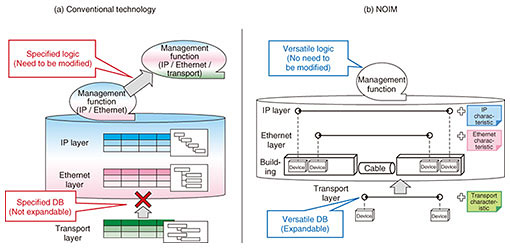 |
|||||||
|
|
|||||||
|
Regular Articles Vol. 18, No. 11, pp. 48–52, Nov. 2020. https://doi.org/10.53829/ntr202011ra2 Technology for Understanding Service Impact Using Network Resource Management Technology that Is Independent of Network TypeAbstractIn large-scale and diverse networks of telecommunications carriers, it is difficult to quickly understand the effects on communication services due to damaged communications buildings and cables. NTT Access Network Service Systems Laboratories is researching and developing network resource management technology that enables unified management of various networks. In this article, we introduce technology for understanding service impact during a large-scale disaster using this network resource management technology. Keywords: network resource management, understanding service impact caused by disasters, management model 1. IntroductionDuring and immediately after large-scale disasters, such as earthquakes and typhoons, it becomes difficult to provide communication services due to damage to communication buildings and cables. Communication services are vital infrastructures for modern society, so those damaged by a disaster must be quickly repaired. The larger the scale and wider the area of a disaster, the more communication equipment will be damaged. It is also necessary to quickly restore important communication services such as lines between government offices responsible for disaster recovery and lines used by many users. However, the networks of telecommunications carriers combine various communication technologies to provide services nationwide, so damage to facilities in one area affects services in other areas as well as other types of services. Therefore, it is difficult to quickly understand the total service impact caused by disasters. In such a situation, there is a demand for technology to enable quick understanding of the service impact caused by disaster-affected equipment and prioritize equipment to be restored from the vast amount of disaster-affected equipment. 2. OverviewWe have been researching and developing network resource management technology called Network Operation Injected Model (NOIM), which enables unified management of various networks [1]. NOIM manages network information in a versatile data format that does not depend on network type, such as network termination points and connectivity, and enables various networks to be managed centrally. It is possible to quickly understand the service impact caused by communication-equipment failure in a complicated carrier network that combines many communication technologies. In addition to the example of storing transport/Ethernet/Internet protocol (IP) network information shown in Fig. 1, NOIM can store a wide range of network information such as leased lines and mobile networks and help in understanding the service impact during a disaster on those networks.
3. Purpose of NOIMNOIM adopts the entity specified in the information framework called shared information/data model (SID) discussed in the TM Forum [2] and enables unified management of network information in a versatile data format. We adopted three types of representative entities among the SID’s logical resources. Termination point encapsulation (TPE), representing termination point of forwarding; network forwarding domain (NFD), representing the opportunity to configure the potential for forwarding; and forwarding relationship encapsulation (FRE), representing all aspects of forwarding of information across a network on NFD. Similarly, NOIM is expressed as a versatile entity with regard to physical resources such as communication devices: physical device (PD), optical fibers: physical link (PL), communication buildings: physical structure (PS), and cables: aggregate section (AGS). Combining these versatile entities makes it possible to express the management information necessary for managing the multi-layer communication protocol (Fig. 2).
Furthermore, when retaining this versatile entity information, NOIM has a mechanism to externally define different information for each communication technology. Since the conventional resource management technology that manages networks has a database (DB) specialized for holding information to be managed for each target network, a management function needs to be added to add or change the managed network. In NOIM, the management function is implemented as versatile logic that does not depend on the network type based on the versatile entity information, so there is no need to modify the management function when adding or changing the network type. Figure 3 compares the conventional technology and NOIM. Consider the case of managing an IP network and Ethernet network as an example.
The conventional technology (Fig. 3(a)) has a DB specialized for an IP + Ethernet network and a management function specialized for those networks. If a transport network is added to the management target, it is necessary to change the DB or modify the management function so that the transport network can be managed. In NOIM (Fig. 3(b)), even when a transport network is added, the data of the transport network can be stored by externally defining their characteristics. The target network can be easily expanded. Similarly, regarding the management function, the logic is based on a versatile entity, and it is not necessary to change the function by adding the transport network. 4. Technology for understanding service impactWith NOIM, we have developed a technology for quickly understanding the service impact caused by disasters. Using the versatile data format entity described above, the information of various communication networks constructed by telecommunications carriers is stored in unified data (Fig. 4).
This technology accepts physical equipment (buildings and cables) damaged by a disaster as an input, searches for logical resource entities related to the damaged equipment, and outputs these entities. It is possible to understand the impact on the communication service that occurs due to propagation damage from the communication equipment. Figure 4 shows an image of searching for the impact of propagation from a physical resource entity to logical resource entities, assuming that the communication cable is damaged. All physical/logical resource entities have information on the hierarchical relationship between layers and the end point of the transfer path, and it is possible to search for the impact across layers using this information. This technology with NOIM does not depend on network type due to tracing the relationship between the entities (termination points, transfer paths, etc.) expressed in the versatile data format and their layers [3]. 5. Future plansWe will implement our technology for understanding service impact during a large-scale disaster by using NOIM through commercial trials. We will also continue to research and develop technology that further enhances and improves the efficiency of disaster response operations. References
|
|||||||
















